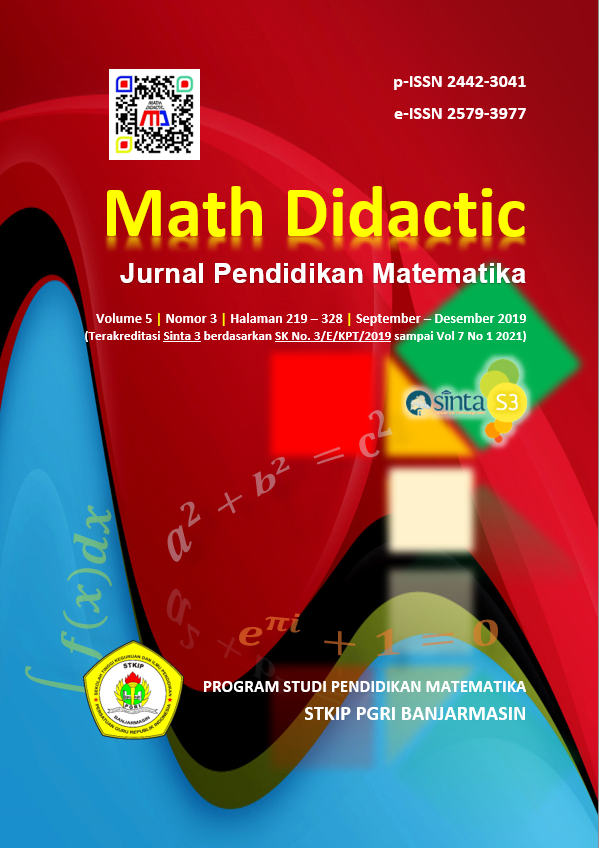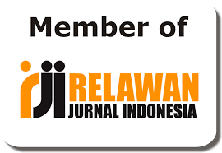Mathematical teacher efforts to develop student's critical thinking skill
Upaya guru matematika dalam mengembangkan kemampuan berpikir kritis siswa
Abstrak
Tujuan: penelitian ini bertujuan untuk mengevaluasi pembelajaran matematika dengan melihat upaya guru matematika dalam mengembangkan keterampilan berpikir kritis siswa di kelas. Penelitian kualitatif ini mengeksplorasi upaya guru matematika dalam mengembangkan keterampilan berpikir kritis. Dua guru matematika dipilih, diamati dan diwawancarai tentang pembelajaran matematika di kelas, lingkungan belajar yang ingin dibuat, dan penilaian dilakukan. Hasil penelitian menunjukkan kedua guru matematika belum mencoba secara maksimal dalam belajar matematika untuk mengembangkan keterampilan berpikir kritis siswa. Kedua subjek belum menciptakan lingkungan belajar yang efektif. Selain itu, penilaian hasil belajar matematika masih dilakukan pada akhir pembelajaran
##plugins.generic.usageStats.downloads##
Referensi
Abrami, P. C., Bernard, R. M., Borokhovski, E., Wade, A., & Michael, A. (2008). Instructional Interventions Affecting Critical Thinking Skills and Dispositions: A stage 1 Meta-Analysis. Review of Educational Research, 78(4), 1102–1134.
Adeyemi, S. B. (2012). Developing critical thinking skills in students : A mandate for higher education in Nigeria. European Journal Of Educational Research, 3(2), 155–161. https://doi.org/10.12973/eu-jer.1.2.155
Anderson, T., Howe, C., Soden, R., & Low, J. (2001). Peer interaction and the learning of critical thinking skills in further education students, 1–32.
As’ari, A. R. (2016). Berpikir Kritis. In E. B. As’ari, Abdur Rahman; Irawan (Ed.), Variasi Konstruk dalam Pembelajaran Matematika (1st ed., pp. 1–21). Malang: CV. Bintang Sejahtera.
As’ari, A. R., Mahmudi, A., & Nurlaelah, E. (2017). Our Prospective Mathematic Teacher Are Not Critical Thinkers Yet. Journal on Mathematics Education, 8(July), 145–156. https://doi.org/10.22342/jme.8.2.3961.145-156
Aun Vong, S., & Kaewurai, W. (2017). Instructional model development to enhance critical thinking and critical thinking teaching ability of trainee students at regional teaching training center in Takeo province , Cambodia. Kasetsart Journal of Social Sciences, 38(1), 88–95. https://doi.org/10.1016/j.kjss.2016.05.002
Bailin, S., Case, R., Coombs, J. R., & Daniels, L. B. (1999). Conceptualizing critical thinking. Curriculum Studies Journal, 31(3), 285–302.
Browne, M. N., & Keeley, S. M. (2015). Asking the Right Questions: A Guide to Critical Thinking. (B. Potthoff, Ed.) (11th ed.). New Jersey: Pearson Education, Inc.
Chaijaroen, S., Kanjug, I., & Samat, C. (2012). The Study of Learners’ Critical Thinking Potential, Learning with Innovation Enhancing Thinking Potential. Procedia - Social and Behavioral Sciences, 46, 3415–3420. https://doi.org/10.1016/j.sbspro.2012.06.076
Chan, C., Lee, E., & Aalst Van, J. (2001). Assessing and Fostering Knowledge Building Inquiry and Discourse. Biennial Meeting of the European Association for Learning and Instruction.
Choi, E., Lindquist, R., & Song, Y. (2014). Effects of problem-based learning vs. traditional lecture on Korean nursing students’ critical thinking, problem-solving, and self-directed learning. Nurse Education Today, 34(1), 52–56. https://doi.org/10.1016/j.nedt.2013.02.012
Cojocariu, V., & Butnaru, C. (2014). Asking questions - critical thinking tools. Procedia - Social and Behavioral Sciences, 128, 22–28. https://doi.org/10.1016/j.sbspro.2014.03.112
Cottrell, S. (2005). Critical Thinking Skills: Developing Effective Analysis and Argument. New Yorl: Palgrave Macmillan.
Dudduan, C., Nirat, & Sumalee, C. (2015). Development of learning management model based on constructivist theory and reasoning strategies for enhancing the critical thinking of secondary students. Educational Research and Reviews, 10(16), 2324–2330. https://doi.org/10.5897/ERR2015.2193
Dwyer, C. P., Hogan, M. J., & Stewart, I. (2012). An evaluation of argument mapping as a method of enhancing critical thinking performance in e-learning environments, 219–244. https://doi.org/10.1007/s11409-012-9092-1
Ennis, R. H. (1996). Critical Thinking. (M. McGuane, Ed.). United States of America: Prentice-Hall, Inc.
Ertmer, P. A., Sadaf, A., & Ertmer, D. (2011). Designing Effective Question Prompts to Facilitate Critical Thinking in Online Discussions. Design Principles and Practice: An International Journal, 5(4). https://doi.org/10.18848/1833-1874/CGP/v05i04/38121
Freeley, A. J., & Steinberg, D. L. (1999). Argumentation and Debate: Critical Thinking for Reasoned Decision Making (12th ed.). United States of America: Wadsworth.
Lai, E. R. (2011). Critical Thinking : A Literature Review Research Report. Retrieved from https://images.pearsonassessments.com/images/tmrs/CriticalThinkingReviewFINAL.pdf
Miri, B., David, B. C., & Uri, Z. (2007). Purposely teaching for the promotion of higher-order thinking skills: A case of critical thinking. Research in Science Education, 37(4), 353–369. https://doi.org/10.1007/s11165-006-9029-2
Moon, J. (2008). Critical Thinking: An Exploration of Theory and Practice (1st ed.). United States of America: Routledge.
Palinussa, A. L. (2013). Students’ Critical Mathematical Thinking Skills and Character:, 4(1), 75–94.
Partnership for 21st Century Skills. (2008). 21st Century skills, education & competitiveness, a resource and policy guide. Tucson, AZ.
Škobalj, E. (2018). Mindfulness and Critical Thinking : Why Should Mindfulness Be the Foundation of the Educational Process ? Universal Journal of Educational Research, 6(6), 1365–1372. https://doi.org/10.13189/ujer.2018.060628
Soffe, S. M., Marquardt, M. J., & Hale, E. (2011). Action learning and critical thinking: a synthesis of two models. Action Learning: Research and Practice, 8(3), 211–230. https://doi.org/10.1080/14767333.2011.614927
Sofroniou, A., & Poutos, K. (2016). Investigating the Effectiveness of Group Work in Mathematics. Education Sciences, 6(30), 1–15. https://doi.org/10.3390/educsci6030030
Strachan, D. (2007). Making Question Work: A Guide to What and How to Ask for Facilitators, Consultants, Managers, Coaches, and Educators (1st ed.). United States of America: Jossey-Bass.
Sweet, S. L. (2009). Critical thinking and knowledge application utilizing a multifaceted group project incorporating diverse learning styles. Teaching and Learning in Nursing, 4(2), 34–36. https://doi.org/10.1016/j.teln.2008.09.001
Thaiposri, P., & Wannapiroon, P. (2015). Enhancing students ’ critical thinking skills through teaching and learning by inquiry-based learning activities using social network and cloud computing. Procedia - Social and Behavioral Sciences, 174, 2137–2144. https://doi.org/10.1016/j.sbspro.2015.02.013
Tiruneh, D. T., Weldeslassie, A. G., Kassa, A., Tefera, Z., De Cock, M., & Elen, J. (2016). Systematic design of a learning environment for domain-specific and domain-general critical thinking skills. Educational Technology Research and Development, 64(3), 481–505. https://doi.org/10.1007/s11423-015-9417-2
Wallace, E. D., & Jefferson, R. N. (2015). Developing critical thinking skills: Assessing the effectiveness of workbook exercises. Journal of College Teaching & Learning, 12(2), 101–109.






















